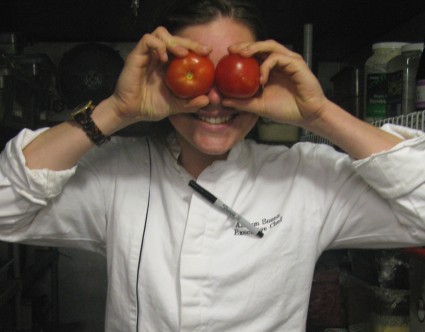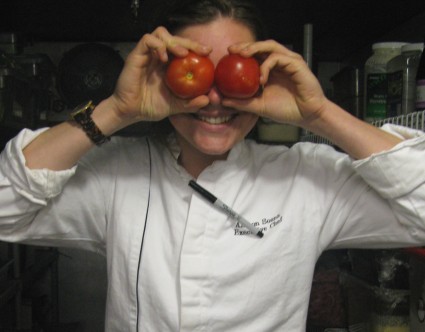 Chef Allison Sosna: doing it right for the kids. This is the second of three articles detailing how food made from scratch using local ingredients is served to students at the Washington Jesuit Academy in Northeast Washington, D.C. The first is here.
Chef Allison Sosna: doing it right for the kids. This is the second of three articles detailing how food made from scratch using local ingredients is served to students at the Washington Jesuit Academy in Northeast Washington, D.C. The first is here.
Allison Sosna is a young chef who fell in love with local produce. She remembers where: it was in a Washington, D.C. restaurant called “Hook,” working with celebrated sustainable seafood chef Barton Seaver.
“We would get amazing produce every day from farmers in Maryland, Virginia and Pennsylvania,” Sosna recalls. “They would just walk through the back door into the kitchen and start unloading all of these ingredients that I had never seen before: candy-striped beets, purple bell peppers, black radishes, pom-pom mushrooms. And I got hooked. I wanted to know what else was out there, these ingredients I had never seen or heard about before–and right in my own back yard.”
Sosna is executive chef at Fresh Start, the for-profit catering arm of D.C. Central Kitchen, a social services innovator that provides much of the food for the city’s soup kitchens and homeless shelters. Fresh Start handles the cafeteria duties at Washington Jesuit School. To make her vision of good-quality local ingredients for Washington Jesuit’s 71 students, Sosna and her crew have had to think hard about costs–and test their resourcefulness. What they’ve learned can teach us important lessons for how to bring healthy food to the nation’s 31 million children who rely on the National School Lunch Program.
Lunch Lessons
Sosna’s infatuation with locally grown food helps explain why cook Eraleigh Green was sorting baby beet greens and mache the morning I arrived to check out the kitchen operation at Washington Jesuit Academy. Sosna insists local produce is not only fresher, more vivid, healthier, “it allows the kids to see what real food is, where it grows, and to establish the connection that food comes from somewhere, and how special and delicious that somewhere is.”
While I looked on, Eraleigh Green carefully rinsed and sorted the ingredients for a diverse salad bar that later would be wheeled out of the kitchen and into the dining hall for lunch service. On the salad bar for the school’s 71 middle-school boys to choose from were mixed salad greens, spinach leaves, sliced mushrooms, sliced radishes, carrots, raw broccoli florets, cucumber slices, red onion, red and golden pear tomatoes, diced beets, bean sprouts, baby beet greens, mizuna leaves, green apples and plums, and a chicken salad made from roasted local chickens.
The kitchen even made two dressings from scratch: Caesar and honey-mustard.
The selection–all of it locally grown–definitely reflects a restaurant chef’s sensibilities and is miles away–about 3,000 miles, to be exact–from the salad I saw being prepared at my daughter public elementary school here in the District when I spent a week in the kitchen there. That salad arrives as plastic bags of processed iceberg lettuce from California, each containing smaller bags of processed carrots and shredded purple cabbage for mixing.
You might well ask whether 11- and 12-year-olds can possibly appreciate the difference between baby mizuna from southern New Jersey and iceberg lettuce from California. But there is more going on here, says Sosna, than designer greens.
Quite a bit of thought and effort has gone into selecting ingredients that aren’t just different and interesting, but fit into the school’s food budget. Specialty items such as the beet greans and mache are purchased when they are on sale, or when the produce distributor is having trouble selling them at all. In fact, provisioning Washington Jesuit Academy with local ingredients has taken months of legwork, endless conversations with farmers, and constant prodding of the Washington area’s agricultural distribution network.
“When you work out partnerships with farmers by explaining to them–vividly–your expectations for deliveries, price points, and volume ordering, you can get local produce into schools,” Sosna says. “It takes time to build relationships, nurture them, and grow them. Through high volume and accurate inventory keeping, you can lower your price points and food costs and still buy local. This is not to say that every ingredient can make its way into your refrigerator. Local corn shoots and micro-greens are still going to be expensive because they take a lot of labor to produce.”
In the world of traditional restaurants, supermarkets and school kitchens, a vast distribution network easily delivers foodstuffs from California, Mexico, Florida and beyond with a simple phone call or the click of a computer mouse. Alas, no such system exists for local foods. Sosna and other enterprising food lovers like her are simply making one up to suit their own needs.
Recently I attended a conference here in Washignton where Doug Davis, the head of school food service in Burlington, Vermont, explained to a group representing school kitchens across D.C. how it has taken him eight years to incorporate local farm products into school cafeterias in Vermont. Making the connection between schools and local farms requires determination and persistence. Local family farmers are just begining to understand the needs of large institutions such as schools.
“As a catering company, I had to ensure that we had inventory and access to all products within a 48-hours notice, and sometimes less,” Sosna explained. “So this requires me to have purveyors that can keep a steady and consistent product in-house and are able to get it to me with a relatively quick turnaround. Over the course of a year, I have been working to get more and more farmers and artisans set up so that I can buy from them consistently and in high volume.”
A year ago, D.C. Central Kitchen hit upon its own scheme for using local produce cost effectively in the 4,000 meals it cooks for the District’s needy every day. The Central Kitchen positioned an employee in the Shenandoah Valley two hours southwest of Washington to start talking with farmers there. Soon, the kitchen was dispatching trucks once or twice a week to purchase “seconds”–produce blemished or otherwise unable to command top dollar–and haul it back to a new processing and storage facility in the city.
D.C. Central Kitchen now makes regular 145-mile trips to a produce auction in Dayton, Virginia, with access to about 100 Shenandoah farmers, to purchase large lots of wholesale fruits and vegetables, some of which is processed and frozen for future use in things like the corn chowder I saw being served to the students at Washington Jesuit Academy.
Sosna said that through the Virginia produce auction, D.C. Central Kitchen in the last year has used more than 50,000 pounds of local fruits and vegetables–50 percent of the kitchen’s total requirement–and directed 10 percent of its total food budget into local products.
The Central Kitchen’s facility is now viewed as a potential model for a proposed city-funded plant that could process local produce for the District’s entire school system. “Healthy Schools” legislation pending before the D.C. Council includes a provision for just such a facility.
If Sosna seems thrilled by local vegetables, she is positively giddy over the organic dairy she’s placed in Jesuit Academy cafeteria. She chose Trickling Springs Creamery, in Chambersburg, Pa., because the company “gets the struggle that chefs like I have with trying to get local produce and ingredients.” Grassfed, hormone-free milk from Trickling Springs is displayed in gallon jugs on the food line for Jesuit Academy students, and the kitchen uses butter and cream for cooking. But getting to that point wasn’t necessarily easy.
“For two months, I worked with this local company to figure out price points, drop-off times, and an invetnory that made sense and ensured a smooth operation,” Sosna said. “This is just one exmple and we are currently using 12 purveyors, from which we use 15 farmers and local artisans.”
The day I visited the Academy, the kitchen had run out of milk. Chef Duane Drake said Trickling Springs only delivers once a week, and he doesn’t have room in his walk-in refrigerator for all the milk the he needs. Instead, they were serving grape drink from powdered mix.
You get what you pay for
Okay, so getting local farm goods into school meals can be done, although not without some effort. But how much does all this cost?
Sosna figures the food cost at Washington Jesuit Academy for each student at around $3.50 per day for breakfast, lunch and dinner. By comparison, the food cost for a typical lunch in a public school is estimated to be around $1, or a little less. But a significant portion of the food used in public schools consists of commodity products donated by the federal governement. Publich schools that participate in the federal meals program receive up to $2.68 in subsidies for each lunch served (about two-thirds of that amount goes to overhead, leaving just a dollar or less for ingredients). Washington Jesuit Academy does not participate in the program and does not receive commodity donations.
While Eraleigh Green was putting the finishing touches on the salad bar, Duane Drake stirred a spaghetti sauce he was making with local plum tomatoes in the kitchen’s free-standing kettle cooker. He began peeling eggplants to add to the sauce, along with the meat from some leftover roasted chickens.
“We were getting organic chicken from a farmer in Pennsylvania, but it was expensive,” Drake says. “We’re looking for a farmer who does his own processing.”
Drake peeled and sliced carrots, scattered these over sheet pans with snow peas to roast in the convection oven for a vegetable side dish. In just a few minutes, there would be a mob of hungry boys–and teachers–clamoring for lunch. It looked like we’d be ready for them.
Monday: why the administration at Washington Jesuit Academy committed to paying more for better school food.




